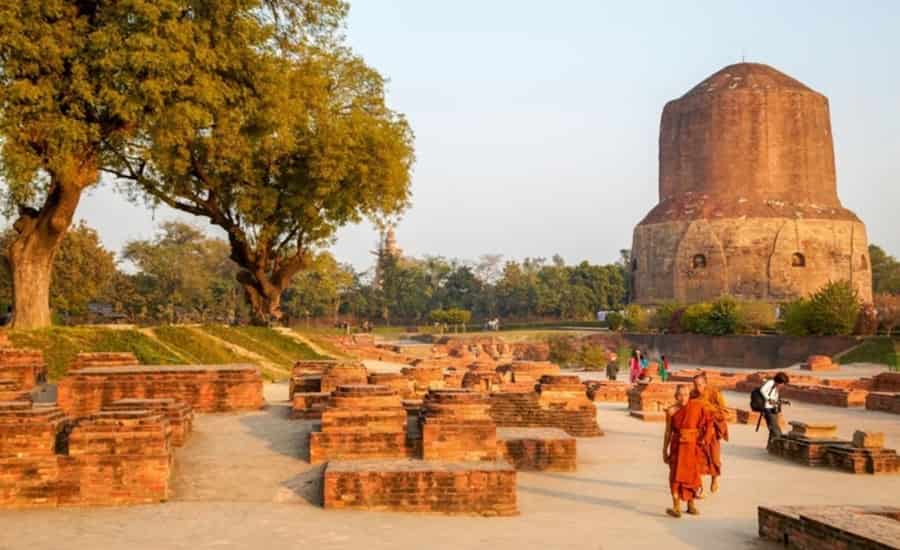Last Updated on 04/03/2024
Dhamek Stupa, situated amidst the serene landscape of Sarnath in Uttar Pradesh, India, stands as a monumental tribute to the profound teachings of Lord Buddha. Constructed over millennia ago by Emperor Ashoka of the Maurya Dynasty, this cylindrical marvel encapsulates the spiritual essence of Buddhism. Its towering presence, reaching 43.6 meters in height and adorned with intricate carvings and inscriptions, serves as a timeless beacon of enlightenment and compassion. As the sacred site where Lord Buddha delivered his inaugural sermon, Dhamek Stupa holds profound significance for pilgrims and seekers alike, offering a sanctuary for introspection, reverence, and spiritual renewal. With its rich history, architectural grandeur, and tranquil ambiance, Dhamek Stupa continues to beckon travelers on a timeless journey of self-discovery and enlightenment.
- Location: Dhamek Stupa is located in Sarnath, Uttar Pradesh, India.
- History: Originally built in 249 BCE by Emperor Ashoka, it marks the spot where Lord Buddha delivered his first sermon.
- Significance: It is one of the four sacred sites associated with Lord Buddha’s life and teachings.
- Architecture: The stupa is a massive cylindrical structure adorned with intricate carvings and inscriptions, reflecting the mastery of ancient artisans.
- Timings: Open for visitors from sunrise to sunset.
- Entry Fee: Rs. 5 per person for Indian citizens, Rs. 100 per person for foreigners. Additionally, there is a fee of Rs. 25 for cameras.
- Best Time to Visit: October to March offers comfortable weather for exploration.
- How to Reach: Easily accessible from Varanasi, located approximately 13 km away. Visitors can hire cabs, autos, or rickshaws to reach Sarnath.

Location
Dhamek Stupa stands majestically at the archaeological site of Sarnath in the state of Uttar Pradesh, India. Sarnath is situated 12 kilometers northeast of Varanasi, a city renowned for its spiritual significance in Hinduism. This ancient site resonates with the teachings of Buddhism, making it a crucial pilgrimage destination for followers of the faith.
History
Constructed originally in 249 BCE by Emperor Ashoka of the Maurya Dynasty, Dhamek Stupa holds profound historical significance. It marks the precise location where Lord Buddha delivered his first sermon, known as the Dharma Chakra Pravartana, to his first five disciples. This pivotal event, occurring after Buddha’s enlightenment in Bodh Gaya, signified the initiation of the Buddhist sangha (community). Over the centuries, the stupa underwent expansions and renovations, with the current structure dating back to the Gupta period, around the 5th-6th century CE.
Significance
The significance of Dhamek Stupa transcends its historical and architectural value. For Buddhists worldwide, it symbolizes the commencement of Buddha’s teachings, encapsulating the essence of enlightenment and compassion. Sarnath itself holds immense importance as one of the four sacred sites associated with Lord Buddha’s life, alongside Lumbini, Bodhgaya, and Kushinagar. The stupa serves as a spiritual beacon, drawing pilgrims and seekers seeking solace, enlightenment, and a deeper connection with the teachings of Buddhism.
Architecture
Dhamek Stupa’s architecture reflects the rich heritage of Buddhist art and craftsmanship. Rising to a height of 43.6 meters and boasting a diameter of 28 meters, the stupa is a solid cylinder constructed with red bricks and stones. The lower portion preserves elements from Ashoka’s era, while the upper sections exhibit intricate floral carvings typical of the Gupta period. The cylindrical structure, adorned with exquisitely carved figures of humans and birds, showcases the mastery of ancient artisans. Inscriptions in Brahmi script adorn the walls, narrating tales of Buddha’s teachings and the evolution of Buddhism over millennia.
Timings and Entry Fee
Dhamek Stupa welcomes visitors from sunrise to sunset, offering ample opportunities to explore its historical and spiritual aura. The entry fee is nominal, with Indian citizens and visitors from SAARC and BIMSTEC nations charged Rs. 5/- per person, while others are required to pay Rs. 100/-. Children up to the age of 15 can enter free of charge, making it accessible to families and students alike.
Best Time to Visit
While Dhamek Stupa can be visited year-round, certain seasons offer a more pleasant experience. The months from October to March, characterized by cooler temperatures and clear skies, are ideal for exploring the site. Avoiding the scorching heat of summer ensures a more comfortable visit, allowing ample time for contemplation and exploration amidst the tranquil surroundings of Sarnath.
How to Reach
Reaching Dhamek Stupa is convenient due to its proximity to Varanasi, a well-connected city in Uttar Pradesh. Varanasi is accessible by air, rail, and road, with frequent flights, trains, and buses connecting it to major cities across India. From Varanasi, travelers can hire cabs, autos, or rickshaws to reach Sarnath, located just 13 kilometers away. The journey offers glimpses of rural life and scenic landscapes, enhancing the overall travel experience.
FAQs
Q-1: What is the significance of Dhamek Stupa?
Ans: Dhamek Stupa marks the spot where Lord Buddha delivered his first sermon, inaugurating the Buddhist sangha and spreading the teachings of enlightenment and compassion.
Q-2: Can visitors offer prayers at Dhamek Stupa?
Ans: Yes, visitors are welcome to offer prayers and circumambulate the stupa as a form of reverence and spiritual practice.
Q-3: Are there any nearby attractions in Sarnath?
Ans: Yes, Sarnath is home to several other significant Buddhist sites, including the Ashoka Pillar, Mulagandha Kuti Vihar, and the Sarnath Museum, which houses ancient artifacts and relics.
Q-4: Is photography allowed at Dhamek Stupa?
Ans: Yes, photography is permitted at the stupa, allowing visitors to capture memories of their spiritual journey and the architectural splendor of the site.
Q-5: What amenities are available for visitors at Dhamek Stupa?
Ans: Facilities such as restrooms, drinking water, and informational signage are available to ensure visitors have a comfortable and informative experience.
In conclusion, Dhamek Stupa stands as a timeless testament to the enduring legacy of Buddhism and the profound impact of Lord Buddha’s teachings. Its historical significance, architectural grandeur, and spiritual aura continue to inspire and captivate visitors from around the world, offering a sacred sanctuary for seekers of truth and enlightenment.
Suggested Tour:


 Call
Call WhatsApp
WhatsApp Enquiry
Enquiry